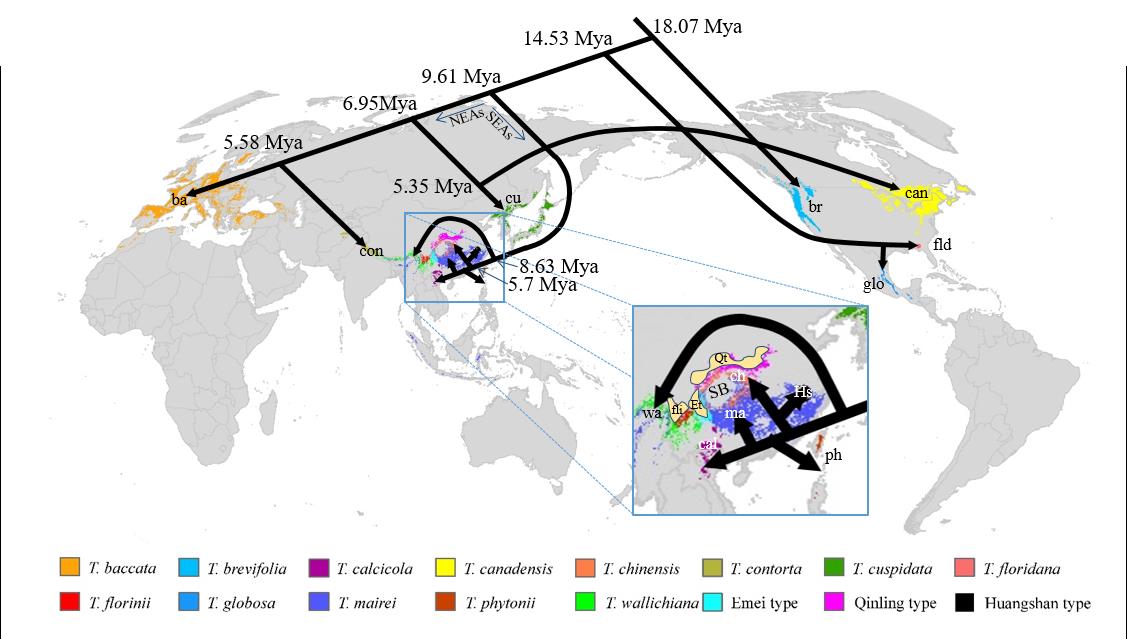Taxus is the most diverse genus within Taxaceae, with 13 recognized species plus three additional cryptic lineages. The genus is broadly distributed across the North Hemisphere, covering North America, Europe, North Africa and Asia. It has acquired great medical significance as the primary source of taxol, a natural antitumour agent with high potential for cancer treatments. However, its species are long-lived but slow-growing with scattered distribution, thus rarely occur in large numbers. Consequently, commercial exploitation and the illegal trade of its bark and twigs for taxol harvest have caused a sharp decline in its natural populations at the risk of local and regional extinction.
The spatiotemporal evolutionary history of this important genus is still unresolved because of taxonomic difficulty and species boundary obscurity. Recently, a team led by professors GAO Lianming and LI Dezhu from the Kunming Institute of Botany, Chinese Academy of Sciences (KIB/CAS), cooperated with Dr. Michael Möller from Royal Botanic Garden Edinburgh, UK, who was a CAS visiting fellow to KIB uncovered the spatiotemporal evolutionary history of all 16 extant Taxus species/lineages by combing molecular phylogeny and biogeography approaches.
The study revealed strong evidence for the hybrid origin of three lineages and dated these events to a rather narrow time window of 6.8-4.9 million years ago (Mya) in the biodiversity hotspot in Southwest China.
The dated phylogenies inferred an Upper Cretaceous origin of the genus, with the extant lineages diversifying in North America much later during the Oligocene/early Miocene. Repeated migrations via the Bering land bridge to Eurasia and back were further inferred, with the return to North America as a possible result of vicariance.
The diversification in Eurasia (from ~8 Mya onwards), coincided with the orogeny of the Hengduan Mountains, the intensification of the East Asian summer monsoon and the occupancy of ecological niches by lineages that experienced secondary contacts and hybridizations in the Hengduan Mountains and Qinling Mountain, especially around the Sichuan basin.
The study provided a hypothesis for the evolution of extant lineages of Taxus, a genus with an old and complex evolutionary history. The study also highlighted that the history of complex species could be unravelled with a careful dissection of phylogenetic signals.
This work entitled: Repeated intercontinental migrations and recurring hybridizations characterise the evolutionary history of yew (Taxus L.) was recently online published in Molecular Phylogenetics and Evolution, a well-known journal in evolutionary biology.
This study was supported by the Strategic Priority Research Program of the Chinese Academy of Sciences (XDB31010000), the National Natural Science Foundation of China (grants 31370252, 41571059, 41971071) and the Chinese Academy of Sciences Visiting Professorship for Senior International Scientists (2011T1S20).

Fig. 1 The divergence time of Taxus and the main geological and climatic events

Fig. 2 Schematic map of divergence and migrations of Taxus across the globe
Contact:
YANG Mei
General Office
Kunming Institute of Botany, CAS
email: yangmei@mail.kib.ac.cn
(Editor: Yang Mei)




